

Experimenting with the cover, or “packaging,” of a given book is a great way to make a book stand out and give it that something extra. All of the books in this chapter feature materials or techniques that aim to achieve exactly this.
From André Lee Bassuet of Kowaikuma’s pillow books to Norman Pointer’s beautifully crafted wood-covered books, to Larissa Cox of Boundless Bookbindery’s cake books and Erica Ekrem of Odelae’s clam shell cases, each pushes the boundaries of design and experimentation. In some cases these covers, and others on the following pages, took the makers many days to create. From finding the right materials to practicing and perfecting the binding and finishing technique, they illustrate the intriguing creative possibilities of bookmaking as an art form.

Three Trees Bindery began as a marriage of two of artist Michelle Skiba’s favorite things: trees and books. “As an avid journal keeper and book collector, creating books from things found in the forest evolved slowly and naturally from my wanderings. Completely taken with the beauty of an acorn, a leaf, or a piece of bark, I was unable to put down these small tokens and they became the source of inspiration for my wooden library.”
Skiba specializes in creating wooden wedding guestbooks and photo albums. She begins her design process by selecting her wood and bark. The goal of her process is to highlight the wood’s natural and organic beauty, which often means highlighting flaws and imperfections. “To me these are the characteristics that make these materials unique. I sand and shape the boards, then use wax, paints, and natural oil finishes.”
To bind the books she uses a slight variation on the traditional Coptic binding. She developed it by changing some of the stitches to create the woven pattern along the spine. “I love the juxtaposition of the simple and rustic covers with the care and precision of the exposed sewing.”
See also:
Coptic stitch
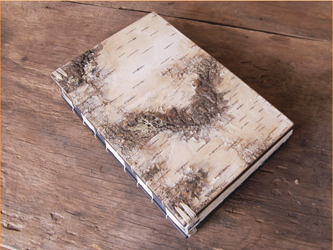

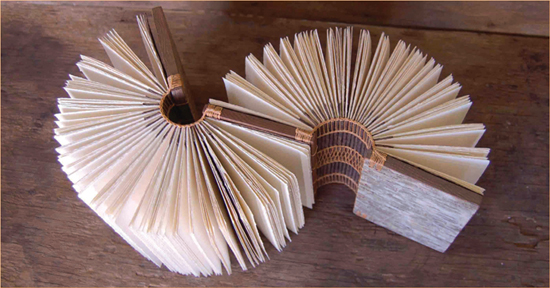

Currently living and working in Cameroon, book artist Julia Nitzsche created the covers for the books shown here using salvaged scraps of fabric. Nitzsche has the pieces of fabric treated using a specially developed coating to strengthen and protect the fabrics and facilitate the weaving technique. As well as weaving covers Nitzsche uses a geometric quilting technique where she places covered boards on top of one another, mixing different fabrics together. She works with traditional, locally acquired printed “pagnes,” as well as a fine cotton called bazin riche, which is used for batik and hand-dyeing.
“With the woven patterns I like to see what happens when two fabrics are interacting.
Since they are large and high contrast, there is an interesting play between the two fabrics and the more rectilinear design of the weaving. I also like the fact that as the larger patterns are interrupted by the weaving, the mind’s eye completes the motifs. With the geometric covers, many types of fabric can be used to cover the boards, and it is in the mix of fabrics that a new type of imagery emerges on the covers.”
See also:
Woven cover



Killside Krafts is run by bookbinder Melodie Kwan, who makes Coptic-bound journals and blackboard-inspired handmade goods. She works with Baltic birch plywood, book board, linen and cotton fabrics, and various papers and elastics when creating her books.
Inspired by early Coptic bindings, which used wooden boards as covers, Kwan found Baltic birch plywood to be a good alternative. It retains the look of solid wood with the woodgrain pattern on both sides, while being around the same thickness as book board, and so ideal for covers.
In some instances, Kwan then laser-cuts designs into the board before assembling all the different book elements together and binding them using Coptic stitch.
See also:
Coptic stitch
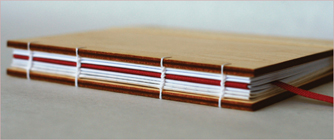



Lucie Forejtova is the artist behind Immaginacija and works as an artisan stationer from her home workshop in Oxford, UK.
“Immaginacija means imagination; even though it is a made-up word and doesn’t come from any particular language, I believe it’s understandable in all languages. My work is all about imagination, and about the imagination of my customers who commission me to create bespoke books. I specialize in making notebooks and journals, but I also create special bindings, limited or special editions of books—poetry pamphlets, for instance.”
Forejtova uses a variety of different styles and materials within her work, including handmade and recycled materials. Shown here are her woven and patchwork cover books, which have an emphasis on color.
To create the woven book Forejtova used strips of various types of papers—handmade, decorative, painted, marbled—to create a woven sheet of paper, which she then used to cover the book board. The patchwork book was created using recycled paper left over from other projects. The books were bound using Coptic stitch.
See also:
Coptic stitch
Woven cover
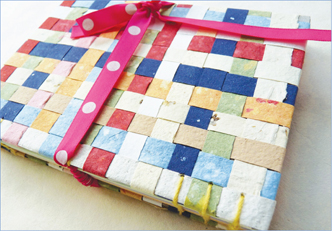
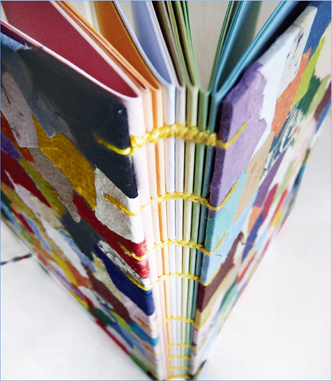

Kowaikuma is run by Brooklyn artist André Lee Bassuet. Kowai kuma, meaning “scary bear,” was a nickname given to Bassuet while studying in Japan: “I loved to hibernate in the winter like a bear and I would get scary without food, sleep, or art. I love to be creatively challenged everyday,” says Bassuet.
Japan is an influence that features in much of her work. The book covers shown here are made from vintage kimonos that have been upcycled into book cloth. The pillow books (below) are a play on a well-known eleventh-century Japanese book of thoughts, poetry, and musings by Sei Shonagon. A court lady to Empress Consort Teishi, Shonagon wrote on sheets that she kept under her pillow, hence the name. Bassuet has created a more literal interpretation with her pillow book covers.
Bassuet favors Coptic stitch for the binding as she can sew messages onto the spine. XOXO (above) is intended to be a gift for a loved one or a romantic journal.
See also:
Book cloth
Pillow book

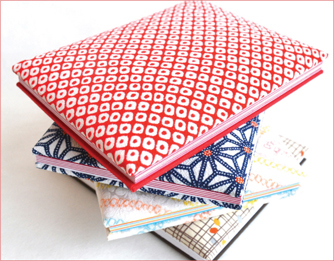

Christer Dahlslett is a graphic designer who, in his own words, likes to work with whatever materials he can get his hands on. As a freelancer he travels around, staying a month or two in different cities before moving on to a new, exciting place. He was attracted to the world of design because of the opportunities to experiment. “I love that I can play around with almost anything. I enjoy experimenting with new materials, new techniques, and new tools, although I always keep in mind what the specific materials and techniques I use will communicate.”
Dahlslett’s book The Water of Life was created as part of his design degree and explores the world of whisky drinking, particularly the “manly” side of it. The book features three individual pamphlet-stitched books housed inside a case made from plywood. “Since this book was about a very ‘manly’ drink I wanted to create a cover that was robust and sturdy. I used plywood which I had laser cut. Once cut, I sanded it down, applied different dyes to stain it, and then glued it together to form the case.”
The text has been burnt onto the wood with a laser cutter, which was also used to cut out the box. Dahlslett used ⅛" (3mm) plywood for the case and three different stocks for the pamphlet-stitched books: 180gsm watercolor stock, a 150gsm stock, and a 110gsm off-white stock.
See also:
Pamphlet stitch




Ewelina Rosinska is a Polish-born graphic designer working across all areas of design, from web design to hand-crafted objects. Shown here is her portfolio, which she created to show her eclectic work together in one place. The hand-bound book also features printed images of her work that have been stitched together before being bound by a board cover. Rosinska chose a patterned design (below) for her endpapers and case lining to make her portfolio unique and distinctive.
“With the creation of this book I wanted to make something personal, and something that showed I care about the details within design.” The book is secured with a ribbon and then housed inside a cardboard case, which again is secured with a ribbon.
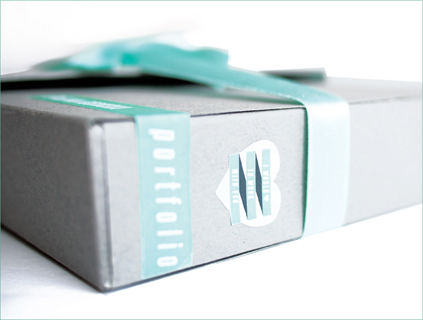


Mareth Cordell is the woman behind Seattle-based company Lime Riot. As a maker she dabbles in many different crafts, including knitting, embroidery, sewing, paper crafts, painting, and clay, but she is always interested in trying something new. As an avid list-maker she was inspired to create covers for the journals and books that she uses to capture her lists, ideas, and inspirations. The fabric covers she creates are removable so that they can be used multiple times on different books or journals.
Cordell stamps a Dewey Decimal library code on the covers to help her identify the purpose of the book, be it for recipes, lists, decorating ideas, sewing, knitting, crafting, and so on.
Each book cover is made using carefully selected complementary fabrics, which Cordell sews together on her sewing machine.
See also:
Fabric cover
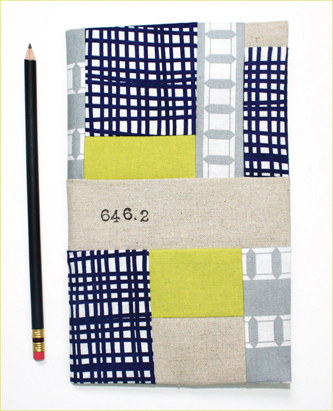


Book artist Norman Pointer is a retired physician who now spends his time creating handmade wood-covered books. His books are made with wood that he collects, and, in some instances, from trees that he has felled himself. He then ages and prepares the wood.
“Because I live near Louisville and the Ohio River I have access to the driftwood that collects at the Falls of the Ohio. This is a good source of material for me, and one of my ongoing projects is making a collection of books using native American woods.”
Once the wood is collected and ready to use Pointer cuts it to size and drills holes in it ready for stitching. He then sands it before he begins sewing his prepared signatures to the cover using Irish waxed linen and Coptic stitch. The woods Pointer uses include sumac, Californian redwood, hackberry, black walnut, wild grape, holly, and bald cypress.
See also:
Coptic stitch
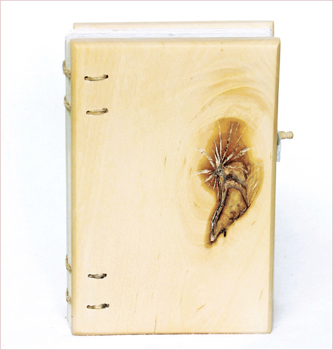


Originally from Bath, England, book artist Larissa Cox now resides in Vienna where she creates beautiful hand-bound books under the name Boundless Bookbindery. These “cake books” were inspired by the city.
“Living as I do in Vienna, home of splendid cakes, it seemed natural to take inspiration from this tradition and create cakes in book form. My aim was to give the books as close an appearance to an actual cake as possible, while still being fully functioning books. Thus they all have the dimensions of a real (quite generous) cake slice.”
Each of the books were case-bound in a normal rectangular shape and then cut by hand into triangular shapes. Cox then added the covers and hand-stitched headbands to each. The inner pages of the cake books are Fabriano Tiziano stock and the covers are made with either bookbinding linen or decorative paper.
See also:
Case binding
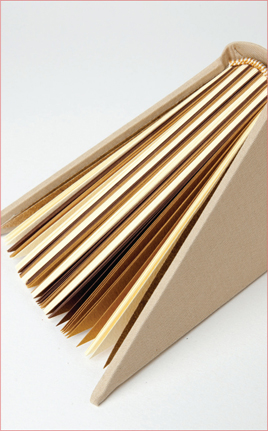


Run by Molly Lewis and Michelle Johnson, Hinged Strung Stitched is a small Portland-based production bookbinding studio, specializing in custom photo albums and one-of-a-kind books, boxes, and portfolios. “We are bookbinders working to keep the traditional art of bookbinding alive and thriving,” say Lewis and Johnson.
This architecture portfolio book created for Matt Fuhr features a Coptic bind and a laser-etched cedar wood cover. The design of the tri-fold book (below) is based on the traditional gatefold binding that Lewis and Johnson modified to create a book that is completely self-contained without requiring a slipcase. “The book is bound using simple pamphlet stitch. Multiple signatures make the binding look elegant and architectural … we refer to it as a long stitch binding because it better describes what the binding actually looks like.”
See also:
Coptic stitch
Pamphlet stitch


Askida was founded by Özlem Kumru who designs and makes hand-bound books and accessories, including bags and hats. Her decorative book covers are mostly made using balsa wood as a base, and then decorated with various materials and objects.
“I love to use an unusual harmony in contradictory objects—such as felts, found objects, gemstones, or beads—to create ‘scenery’ on the cover.” Kumru is a self-taught bookbinder who began researching historical bookbinding techniques after graduation. Kumru stitches her chosen objects onto ⅙" (4mm) balsa wood covers using cotton thread. She binds her books with various stitches, including Secret Belgian and Coptic, using either waxed cotton thread, raffia straw thread, or cord. Kumru uses 160gsm Canson paper for the inside pages of her books.
“I love the pattern that the thread creates on the cover and spine when using the Secret Belgian binding technique. However, I tend to use Coptic stitch on the smaller books I make, simply because of the smaller dimensions.”
See also:
Coptic stitch
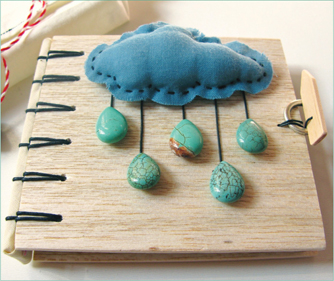
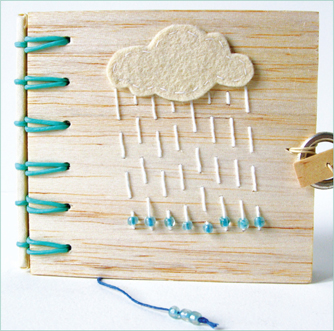

Odelae is run by graphic designer and bookbinder Erica Ekrem.
“I strive to live in harmony with my environment and find myself continually seeking a balance between the natural world and the one created by mankind. I work with found materials—mostly vintage and natural objects such as clam shells and driftwood.”
The idea for the shell book shown here came from a walk on the beach. Part of a series, the first book was made from a clam shell but Ekrem has since used scallop, cockle, and oyster shells. The textblock within was created using smooth white 100-percent recycled writing paper. It was then assembled together with the shells, which were pre-drilled with holes, ready for attaching to the textblock. Then, it was bound using Coptic stitch and linen thread.
Ekrem chose Coptic stitch because it reflects the simplicity and humbleness of the shells she repurposes. As it is non-adhesive, the shell books are 100 percent biodegradable.
See also:
Coptic stitch
